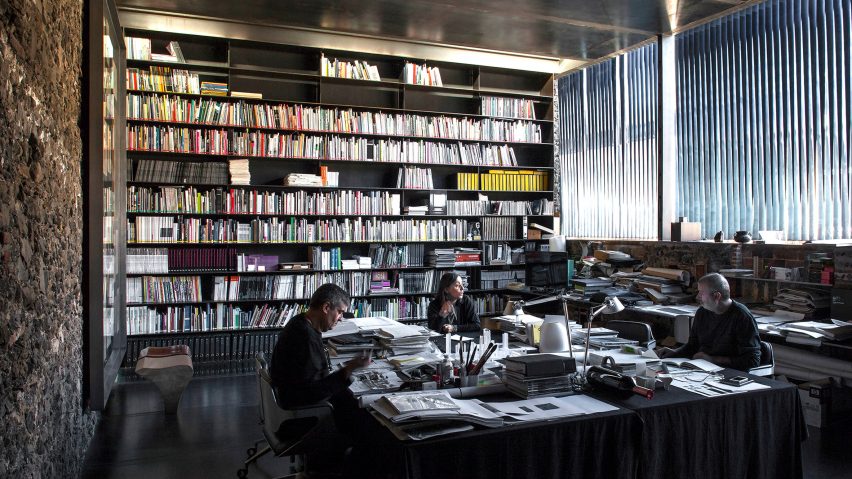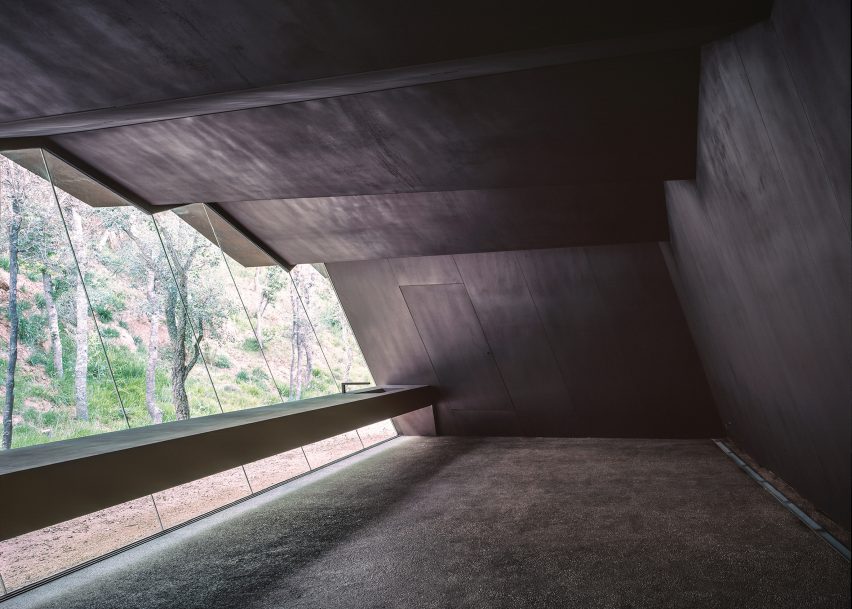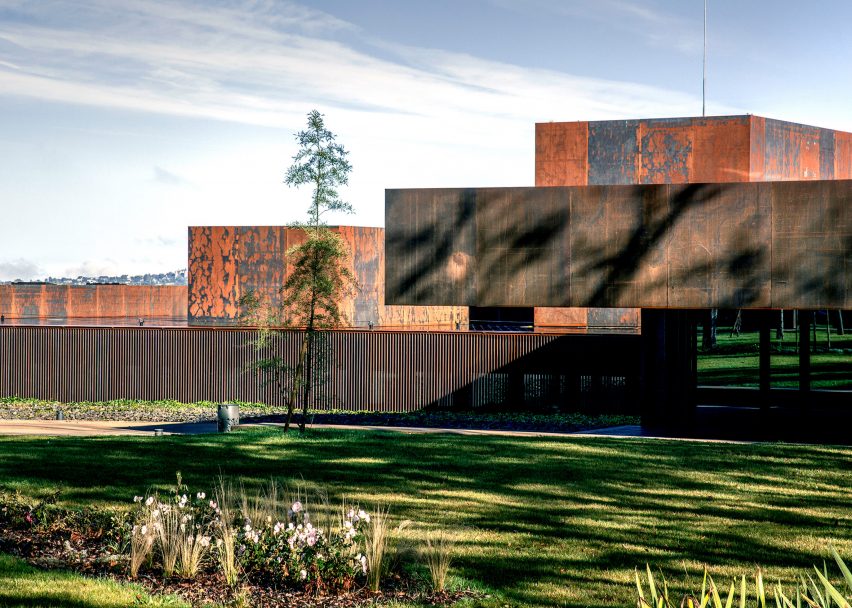
"RCR's work is under the radar, yet it is stealthily evolving in scale and ambition"
Awarding the Pritzker Prize to little-known RCR Arquitectes is a quiet rebuke against the superficiality and greed that has dominated architectural culture around the world, says Catherine Slessor in this Opinion column.
When it was announced that Catalan trio RCR had been awarded this year's Pritzker Prize, the initial sentiment that engulfed the chattering conduits of social media was "Who they?", swiftly followed by "Why they?" The first question is easy to answer, the second a more complex voyage of discovery.
Founded in 1988, RCR Arquitectes is an abbreviation of the first names of its founding principals Rafael Aranda, Carme Pigem and Ramon Vilalta, who met while studying at the Vallès School of Architecture near Barcelona.
Their office is located in Olot in the volcanic terrain of northern Catalonia, hometown of both Aranda and Pigem. In the shadow of the Pyrenees, Olot puts physical and experiential distance beyond the gravitational pull of Barcelona's architectural milieu, enabling the trio to develop at their own pace and in their own way.
The region's distinctive landscape of lava deposits, terraces, stone walls and tree-lined streams acted both as a crucible and inspiration for RCR's early work. They responded to this topography not by imitation, but through processes of reconceptualisation and abstraction. Their tautly muscular buildings combine subterranean volumes with floating superstructures through which daylight percolates into shadowy interiors. Use of steel columns and slatted-steel cladding imply geometric abstractions of trees, the arboreal becoming manmade. Drawn to Catalonia's rural vernacular, RCR conceive of architecture in territorial terms but rather than regressing into picturesque nostalgia, the local forms the synthetic germ of something much harder and identifiably modern.
Drawn to Catalonia's rural vernacular, RCR conceive of architecture in territorial terms
Set in a former industrial foundry in the backstreets of Olot, the design of their office reflects this tough yet poetic approach. It is an environment defined by various tones and textures of black and dark steel, sometimes varnished and shiny, like oriental lacquer. Visitors report the partners sliding around silently in black slippers.
Within this ascetic domain of dark pierced by light, there is a strong suggestion of Japanese sensuousness and rigour. And it seems especially appropriate that the carcass of a factory where metal was originally wrangled and wrought now forms an incubator for RCR's work, so deeply inflected by its investigation into architecture's primary relationship with materials.

Ramon Vilalta says they are "interested in dematerialisation but also in the directness of materials". Some projects are intensely material, such as the winery at Bell-lloc, a giant comb of rusted steel wedged into the ground with the brute force of a Richard Serra sculpture. Others aspire to dematerialisation, such as the new public space created in the wake of the demolished La Lira theatre in Ripoll. Here, the void left by the theatre is redefined by a monumental yet curiously delicate proscenium of steel louvres, "a neutral scenography activated by users", according to Carme Pigem. Some, such as the Marquee for Les Cols Restaurant, with its heavy, granular base and floating roof made from diaphanous layers of translucent plastic, are both material and immaterial: simultaneously "petrous and ethereal", as Vilalta describes it.
There is a strong suggestion of Japanese sensuousness and rigour
Giving shape to ideas and intuitions about the world, RCR's work emerges not out of the proscriptive pretentiousness of theoretical constructs but through the less inhibited medium of freehand sketches and ink-wash drawings freighted with the sharp, minimal acuity of abstract paintings. What starts out as a vague liquid blob of ink or watercolour ends up as a concise construction in steel and glass, disciplined by geometry and structure.
The appeal of their architecture lies in this constant expressive tension between the lyrical and the intellectual, the organic and the systematic. It raises issues of authorship but Arana, Pigem and Vilalta are always resistant to say who does what, comparing their technique to a kind of improvisation, like a jazz trio, with one member laying down a theme and the others picking it up and extemporising on it.
Like many architects in Spain, RCR are often confronted with patchy and ill-defined peripheral conditions, neither urban nor rural, atomised by development. Their reading of this transitional terrain works across several scales, encompassing topographical boundaries, agricultural traces and industrial infrastructure. They are fascinated by the idea of sites as layered accretions from different periods in history, the physicality of landscape inscribed with the geometry of human occupation. Each site is approached with a sort of metaphorical divining rod to unearth the hidden structure and forces beneath the surface, and their projects often assume the character of artificial landscapes, radically transforming existing terrain.

As their reputation has quietly grown, they have extended beyond their Catalan sphere of operations to design a crematorium in Belgium and a museum for the works of Pierre Soulages, the French abstract "painter of black", in his birthplace of Rodez. Conceived as a series of Corten containers set into a hillside, it is one of their largest projects to date. Describing it as "well-placed boxes emerging from the earth laid out with air between them", Rafael Aranda reduces it to its absolute essence, though it is more than that. The boxes act as an atmospheric armature for framing both the art and the surrounding town. Architecture and landscape merge into one another like the painter and his work, an inherent, symbiotic world of light and dark, nature and artifice, abstraction and emotion, from which nothing can be removed.
The Pritzker brings wider public attention to three thoughtful and talented individuals
Established for nearly 30 years, RCR's trajectory needs to be considered against the wider impetuses that have catalysed contemporary Spanish architecture. In particular, the disastrous distraction of imported spectacle embodied by Peter Eisenman's City of Culture in Galicia and Frank Gehry's Bilbao Guggenheim. Critical emphasis on such extrinsic extravagances has tended to overshadow the richness and substance of native practice, with its deep roots in modernism, landscape and locality.
Characterised by a laconic intensity and operating outside the main centres of architectural activity, it is perhaps not surprising RCR's work is seen as being under the radar, yet it is stealthily evolving in scale and ambition. The Pritzker merely puts it into more explicit focus and the capacity of an international awards jury to see beyond the usual suspects should be acknowledged. It brings wider public attention to three thoughtful and talented individuals, whose achievements stand as a quiet rebuke to a global architectural culture increasingly driven by the asocial forces of superficiality, lifelessness and greed.